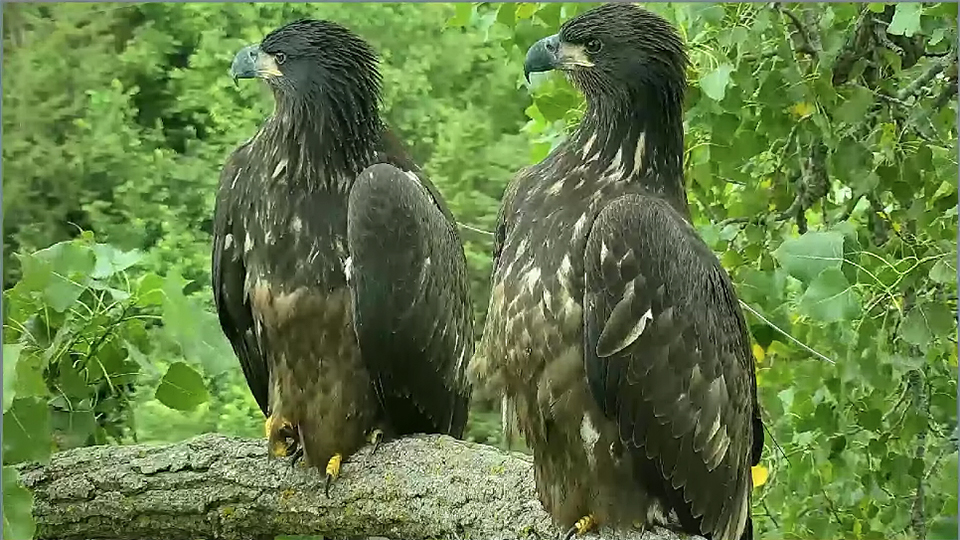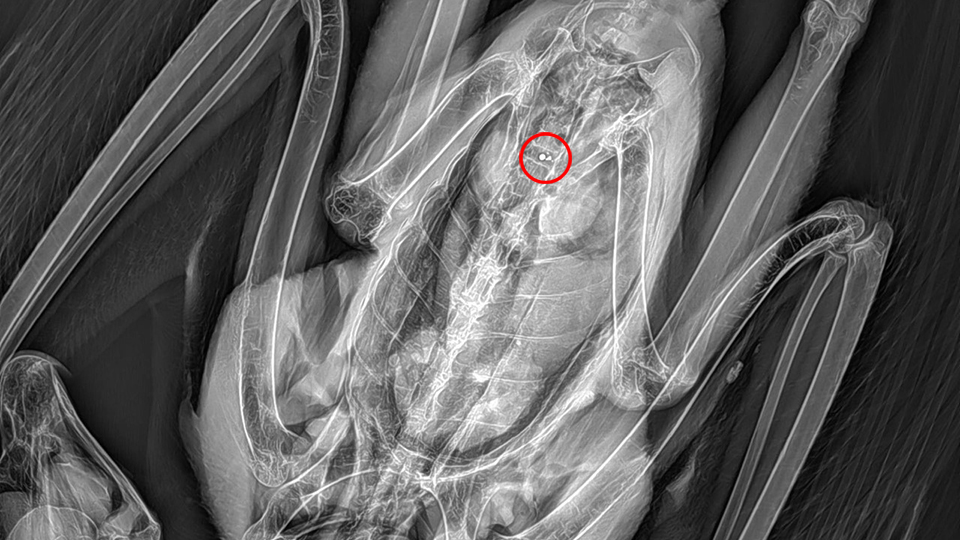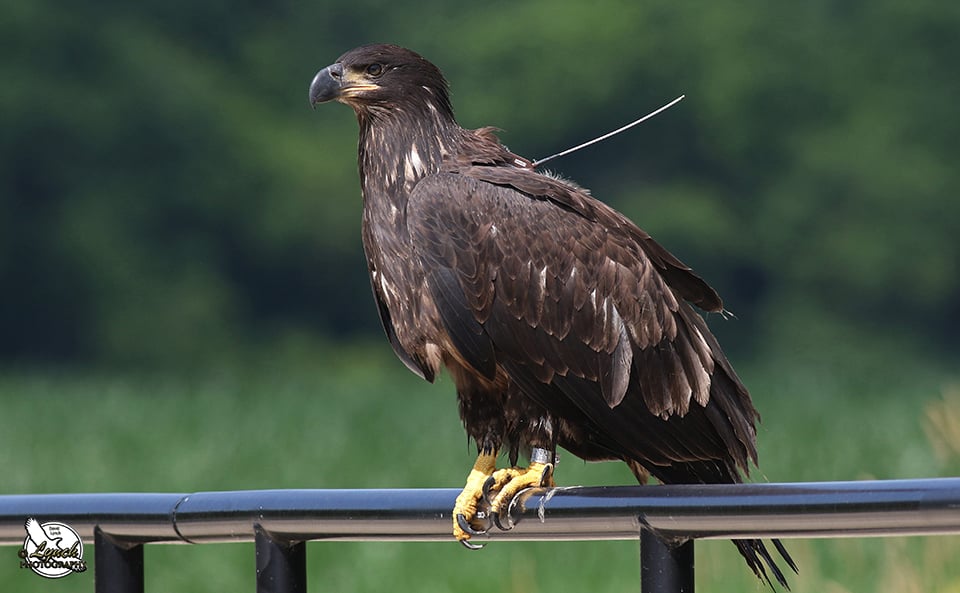We are sorry to announce that RRP Board member Brett Mandernack found eaglet D35 dead on January 29, 2021, along the banks of the Iowa River just south of Iowa City. All of us find it heartbreaking to lose another eagle. It is one thing to know that first-year bald eagles have high mortality rates and another to see it reflected in the lives of eagles we have come to know and love.

D35 and D36
Brett, his wife Carole, and Linette Bernard from Saving Our Avian Resources (SOAR), found D35 buried in snow, with only the antenna from her transmitter visible above the crust. Brett conducted a field examination. D35 was plump and in excellent feather condition, with no foot or transmitter damage. She looked healthy overall and Brett was unable to find a cause of death.
Diagnosis: Acute lead poisoning

D35’s X-Ray. Shot is circled in red
SOAR founder and director Kay Neumann conducted an expert necropsy of D35’s body, including an X-ray and an analysis of her digestive tract, and concluded that acute lead poisoning caused D35’s premature death. D35 had high levels of lead in her blood and body fluids, Kay found a #6 lead shot pellet in her stomach, and the X-ray discovered smaller shot pieces eroded by her strong stomach acids. D35’s liver analysis also found very high levels of lead, although she had healthy body fat reserves and her tail was clean – unstained by the discolored green mutes that often accompany chronic lead poisoning. The lead must have overtaken her quickly.
What is #6 shot and why does it matter?
Hunters use #6 shot for taking medium-sized and larger upland game birds. #6 is generally the smallest load for pheasant, grouse, or chukars, but hunters use it on game ranging from squirrels to turkey. We’ve tended to focus on deer hunting, which takes larger bullets and slugs. But small game shot also poisons eagles. When Kay finds lead in an eagle’s digestive tract, she finds lead shot about one-third of the time and lead shrapnel from bullets or slugs about two-thirds of the time. Lead poisoning is the leading cause of mortality for adult female bald eagles and some researchers consider it to be a population-level problem.
How did lead shot kill D35? Scavenging animals consume lead when they eat animal carcasses or gut piles that contain lead shot or lead shrapnel. This is completely preventable! Many hunters make a conscious decision to hunt ethically and change hunting traditions in their families for the better, which includes moving to non-lead options. We can and should buy non-toxic/unleaded ammo for all game hunting. It protects everyone who eats the game we put on our tables and prevents the lead-related death of non-target species, like bald eagles, that eat carcasses and gut piles.
Remembering Our Eagles
We have tracked nine eagles to date: D1, D14, Four, Indy, D24, D25, D27, D35, and D36. All nine grew up in a world heavily impacted by human beings. Sometimes this has benefits: the Decorah fish hatchery provides an excellent source of food, Mom and DM2 line their nest with cornstalks, and fledgling eaglets perch on power poles and roofs as they learn to fly. But it also comes with dangers, including electrocution, collision, and poisoning. Bald eagles as a species are thriving, but it still hurts to lose an eagle we know and to know that so many others are lost to preventable causes.

David Lynch took this photo of D35 landing on the bridge on Siewers Spring Road near the Decorah Fish Hatchery on July 3, 2020. Thank you to David for sharing his lovely photo and to Brett Mandernack and his staff for sharing their data. Brett’s transmitter study has revealed that power infrastructure, agriculture practices, collisions, toxins, and habitat change/loss all contribute directly to premature bald eagle deaths. These lessons are terribly painful, but they also help us preserve and protect raptors. Whether you drive slowly near road kills, pick up trash, report collisions and electrocutions, advocate for safeguards on power lines and poles, use lead-free ammunition and tackle, preserve habitat, or share information with family and friends, we thank you for reducing your impact on birds of prey.
Learn more
To learn more about alternatives to lead ammo and lead-ammo-related poisoning in birds and other animals, follow these links:
Lead-free ammo and fishing tackle are better for us, for wildlife, and for our rivers and lakes. Several states have full or partial bans on leaded/toxic ammo and tackle and several others are considering them. Check your legislature, read the outdoors section of your paper, talk with local advocacy groups, or search for terms like lead free ammo [your state] legislature to learn about lead-free movements in your state.
How did Brett know there was a problem? D35’s sensor data was static, her location hadn’t changed significantly, and she was too cold. After finding D35, Brett decided to do a wellness check on D36. While he didn’t find D36 that day, further sensor data shows that D36 is healthy and moving well.
 The Raptor Resource Project
The Raptor Resource Project The Raptor Resource Project
The Raptor Resource Project